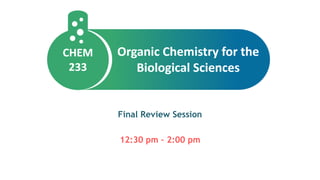
Final Review 2022 S1.pdf
- 1. Final Review Session 12:30 pm – 2:00 pm
- 2. The terminal hydrogens on allene, pictured below, lie in planes that are perpendicular to each other. Draw the σ and π-bonding framework to explain why.
- 3. Arrows!
- 4. Circle all true statements about stereochemistry. i) Two molecules that are enantiomers are chiral ii) A 50:50 mixture of diastereomers will not rotate plane polarized light. iii) Meso compounds have no chiral centres. iv) Enantiomers have different physical properties v) Achiral compounds can exist as diastereomers vi) Switching the methyl and hydrogen on propene leads to a new stereoisomer. vii) A meso compound can have a chiral diastereomer
- 5. Major contributing resonance structure
- 6. Which of the following molecules are aromatic?
- 7. Which of the following molecules are aromatic?
- 8. Identify the molecule with the lowest pKa a) b) c) d)
- 9. Identify the molecule with the lowest pKa (pKa of hydrogen in red) a) b)
- 10. Rank the following from least to most acidic.
- 11. Which of the following in each pair is more basic?
- 12. Rank the following electrophiles in order from slowest to fastest SN2 reaction rate.
- 13. Rank the following carbocations from slowest to fastest-forming from their respective alkenes.
- 14. Fischer to chair
- 15. E2 Complete the template which would react under the noted conditions to provide the alkene product as the only stereoisomer
- 16. The reaction of alcohol D and acetone in the presence of anhydrous HCl in an attempt to prepare ketal E led to the formation of unexpected side product F. Write a mechanism for the formation of F.
- 24. Using any of the molecules in the box, synthesize the following compound.
- 25. Draw the product(s) of the following reaction: Stereochemically, how are the products related? a) Enantiomers b) Diastereomers c) There is no stereochemistry d) There is only one product e) None of the above Δ
- 26. Provide a mechanism for the following reaction: H2O
- 27. Draw the product(s) of the following reaction:
- 28. The expected product of the following reaction was not isolated. Explain why. cat. H2SO4 Δ
- 29. The expected product of the following reaction was not isolated. Explain why. cat. H2SO4 Δ
- 30. Under E1 conditions, the top molecule yields two isomers, while the lower molecule gives only one isomer. Provide the outcome of each reaction, and explain the differences in regioselectivity. cat. H2SO4 Δ cat. H2SO4 Δ
- 31. The following reaction does not give any aldol products. Explain why. NaOMe HOMe Δ
- 32. The following synthesis does not yield the desired products. (i) Explain why and (ii) propose an alternative synthesis. cat. H2SO4 H2O
- 33. The following synthesis does not yield the desired product. (i) Explain why and (ii) propose an alternative synthesis. NaOH H2O
- 34. The following synthesis does not yield the desired product. (i) Explain why and (ii) propose an alternative synthesis. NaOEt HOEt
- 35. The following synthesis does not yield the desired product. (i) Explain why and (ii) propose an alternative synthesis. 1 equiv. LDA iPrBr
- 36. The following synthesis does not yield the desired product. (i) Explain why and (ii) propose an alternative synthesis. NaOH, H2O CH3I
- 37. Thiols can be added to ketones, under acidic conditions, to form an acetal equivalent known as a thioacetal. Propose a mechanism for this process.
- 38. • Provide a mechanism for the following transformation.
- 39. In seawater, CO2 and H2O react to form carbonic acid. Draw a mechanism for this process. Assume catalytic acidic conditions.
- 40. Provide a mechanism for the following transformation:
- 41. Provide a mechanism for the following transformation:
- 42. Provide a mechanism for the following transformation:
- 43. Provide a mechanism for the following transformation:
- 44. For each set, rank the following from least to most reactive to nucleophiles.
- 45. Synthesize the following molecule from (i) diethyl malonate and (ii) acetoacetic ester.
- 46. Synthesize the following molecule from (i) a single organic compound and (ii) two separate organic compounds.
- 47. Synthesize the following (racemic mixture), starting with an aldehyde or ketone.
- 48. The Wieland-Miescher ketone (below) is a molecule used in the synthesis of several natural products, including steroids. Propose a synthesis of this molecule.
- 49. Identify which compounds can be made directly from a/ an (multiple answers possible): (A) Aldol addition (B) Aldol condensation (C) Claisen condensation (D) Dieckmann cyclization (E) NAS reaction (excluding Claisen)(F) Alpha alkylation (G) None of the above
- 50. Identify which compounds can be made directly from a/ an (multiple answers possible): (A) Aldol addition (B) Aldol condensation (C) Claisen condensation (D) Dieckmann cyclization (E) NAS reaction (excluding Claisen)(F) Alpha alkylation (G) None of the above
- 51. Alcohol A (C6H14O) is chiral. Reacting A with PBr3, NaSCH2CH3 in DMSO gives optically pure compound B (C8H18S). Compound A additional reacts with cat. H2SO4, CH3O to give an optically active mixture of ether C (C7H16O). Draw compounds A, B and C. Any stereoisomer of A is sufficient, but B and C must be consistent with A. A C B
- 52. Carbonyl A (C5H10O) gives a negative Tollens test. Treatment of A with LDA and ethyl bromide gives a racemic mixture of compound B (C7H14O). Draw compounds A and B. A B